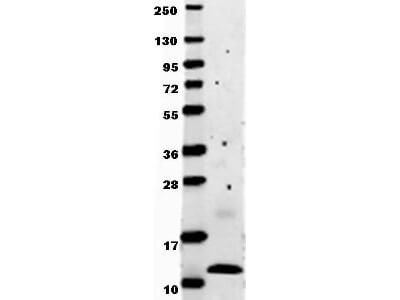Anti-Human MCP-1 (RABBIT) Antibody
MCP-1 Antibody
- SPECIFICATION
- CITATIONS
- PROTOCOLS
- BACKGROUND

| Host | Rabbit |
|---|---|
| Conjugate | Unconjugated |
| Target Species | Human |
| Reactivity | Human |
| Clonality | Polyclonal |
Application
| WB, E, I, LCI |
| Application Note | This purified antibody has been tested in western blotting and suitable in ELISA. Specific conditions for reactivity should be optimized by the end user. Expect a band approximately 11,025 Da in size corresponding to the mature human MCP-1 protein by western blotting in appropriate cell lysate or extract. |
| Physical State | Lyophilized |
| Buffer | 0.02 M Potassium Phosphate, 0.15 M Sodium Chloride, pH 7.2 |
| Immunogen | This IgG fraction antibody was prepared from rabbit antiserum after repeated immunizations with mature length recombinant human MCP-1 protein produced in E.coli. |
| Reconstitution Volume | 100 µL |
| Reconstitution Buffer | Restore with deionized water (or equivalent) |
| Gene ID | 6347 |
|---|---|
| Other Names | 6347 |
| Purity | This product is an IgG fraction antibody purified from monospecific antiserum by a multi-step process which includes delipidation, salt fractionation and ion exchange chromatography followed by extensive dialysis against the buffer stated above. This antibody is specific for human MCP-1 protein. A BLAST analysis was used to suggest cross-reactivity with MCP-1 from human sources based on 100% homology with the immunizing sequence. Based on 98 to 100% homology, there is a chance of cross-reactivity to MCP-1 from chimpanzee, orangutan, macaque, and baboon. Cross-reactivity with MCP-1 from other sources has not been determined. |
| Storage Condition | Store vial at 4° C prior to restoration. For extended storage aliquot contents and freeze at -20° C or below. Avoid cycles of freezing and thawing. Centrifuge product if not completely clear after standing at room temperature. This product is stable for several weeks at 4° C as an undiluted liquid. Dilute only prior to immediate use. |
| Precautions Note | This product is for research use only and is not intended for therapeutic or diagnostic applications. |
| Name | CCL2 |
|---|---|
| Synonyms | MCP1, SCYA2 |
| Function | Acts as a ligand for C-C chemokine receptor CCR2 (PubMed:10529171, PubMed:10587439, PubMed:9837883). Signals through binding and activation of CCR2 and induces a strong chemotactic response and mobilization of intracellular calcium ions (PubMed:10587439, PubMed:9837883). Exhibits a chemotactic activity for monocytes and basophils but not neutrophils or eosinophils (PubMed:8195247, PubMed:8627182, PubMed:9792674). May be involved in the recruitment of monocytes into the arterial wall during the disease process of atherosclerosis (PubMed:8107690). |
| Cellular Location | Secreted |
| Tissue Location | Expressed in the seminal plasma, endometrial fluid and follicular fluid (at protein level) (PubMed:23765988). Expressed in monocytes (PubMed:2513477). |

Thousands of laboratories across the world have published research that depended on the performance of antibodies from Abcepta to advance their research. Check out links to articles that cite our products in major peer-reviewed journals, organized by research category.
info@abcepta.com, and receive a free "I Love Antibodies" mug.
Provided below are standard protocols that you may find useful for product applications.
Background
MCP-1, or Monocyte chemoattractant protein 1, of the intercrine beta (chemokine CC) family, is a chemotactic factor that attracts monocytes and basophils but not neutrophils or eosinophils. It augments monocyte anti-tumor activity and has been implicated in the pathogenesis of diseases characterized by monocytic infiltrates, like psoriasis, rheumatoid arthritis or atherosclerosis. It may be involved in the recruitment of monocytes into the arterial wall during the disease process of atherosclerosis. MCP-1 exists as a monomer or homodimer; in equilibrium. It binds to CCR2 and CCR4 and is tethered on endothelial cells by glycosaminoglycan (GAG) side chains of proteoglycans. Processing at the N-terminus can regulate receptor and target cell selectivity. Deletion of the N-terminal residue converts it from an activator of basophil to an eosinophil chemoattractant.
If you have used an Abcepta product and would like to share how it has performed, please click on the "Submit Review" button and provide the requested information. Our staff will examine and post your review and contact you if needed.
If you have any additional inquiries please email technical services at tech@abcepta.com.













 Foundational characteristics of cancer include proliferation, angiogenesis, migration, evasion of apoptosis, and cellular immortality. Find key markers for these cellular processes and antibodies to detect them.
Foundational characteristics of cancer include proliferation, angiogenesis, migration, evasion of apoptosis, and cellular immortality. Find key markers for these cellular processes and antibodies to detect them. The SUMOplot™ Analysis Program predicts and scores sumoylation sites in your protein. SUMOylation is a post-translational modification involved in various cellular processes, such as nuclear-cytosolic transport, transcriptional regulation, apoptosis, protein stability, response to stress, and progression through the cell cycle.
The SUMOplot™ Analysis Program predicts and scores sumoylation sites in your protein. SUMOylation is a post-translational modification involved in various cellular processes, such as nuclear-cytosolic transport, transcriptional regulation, apoptosis, protein stability, response to stress, and progression through the cell cycle. The Autophagy Receptor Motif Plotter predicts and scores autophagy receptor binding sites in your protein. Identifying proteins connected to this pathway is critical to understanding the role of autophagy in physiological as well as pathological processes such as development, differentiation, neurodegenerative diseases, stress, infection, and cancer.
The Autophagy Receptor Motif Plotter predicts and scores autophagy receptor binding sites in your protein. Identifying proteins connected to this pathway is critical to understanding the role of autophagy in physiological as well as pathological processes such as development, differentiation, neurodegenerative diseases, stress, infection, and cancer.


